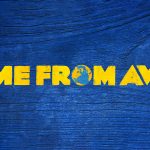Present Music and that other Prokofiev
The orchestra made the sorts of woozy, scratchy sounds DJs make on turntables early in Gabriel Prokofiev’s Concerto for Turntables and Orchestra, which Present Music performed Saturday. Later, DJ Madhatter (aka Jordan Lee) turned the tables: He made sounds the orchestra made — literally. The source material on his vinyl was the orchestra part, although we didn’t realize that until he played it back more or less strait somewhere in the third movement.
That was smart and funny, like most of this ground-breaking concerto. Prokofiev has demonstrated that this hip-hop instrument can interact sensibly with real live music played from dots on lines and spaces. The composer even wrote out the turntable part, with detailed rhythms and approximate pitch. Madhatter had it all under control, from the lighting-quick rhythmic exchanges with the orchestra of 20 or so to the free-form cadenzas. He and Prokofiev even managed a bit of lyricism, which Lee expressed in patient rhetorical phrases.
Prokofiev is fond of ostinato+melody. That is one of the oldest, simplest textures in music, but he’s clever and fresh with it. Ostinatos cropped up a lot in the concerto and in a sampling of three movements from his two string quartets. The relatively simple quartets are tuneful, mostly modal, immediately comprehensible and without irony. This music is not naïve, but an appealing, innocent charm wafts about it.
Artistic director Kevin Stalheim opened this season-opener, played to a big crowd at Turner Hall, with Ingram Marshall’s Sea Tropes, the one contemplative amid the charm and hi-jinks. The recorded surf and a low call, rather like the sound of a foghorn, give the piece a deep, sighing rhythm. A live ensemble comprising marimba, flute, violin, bass clarinet and cello overlays a long, folkish descending melody in free canon in the outer sections. A percolating marimba figure drives the livelier middle section.
This was the last Present Music concert for Philip Bush, the group’s main pianist since 1976. He went out with Ligeti’s Piano Concerto, a raucous carnival of blazing, chiming colors , crazy cross-rhythms, cartoon gestures and bee-swarms of figuration (xylophone and piano buzzing away simultaneously in their top ranges, for example).
The expanded ensemble, with Stalheim conducting, charged through this very difficult piece with exactly the exhilarating energy and abandon it requires, with Bush setting the tone at the center of it all. That guy will be hard to replace.
























I now appreciate why some cartoons depict a DJ as an octopus. The turntable is not just something to abuse by creating a scratching noise. A dozen controls to turn or slide shape the sounds. A computer feed and two vinyl turnables serve as raw material. I would like have seen this performance with a large overhead mirror such as that used by cooking demonstrations. Jordon Lee found a grove that energized the music. But watching him keep up with it all was a key part of the performance.
Despite the variety of options, the turntable system is not a precise digital tool, but severely analog. There appeared to be few ways to fine-tune the result. Perhaps a more directly programmed environment with specific settings for the range of effects – will replace this very difficult “instrument.” But the spontaneity and imprecision was a part of the charm of the piece.
Ligeti’s Piano Concerto, although sounding as spontaneous, was difficult to play because it was precise. I particularly appreciated the xylophone player – who not only kept up with frenetic syncopated piano part, but did it with a whistle in her mouth.